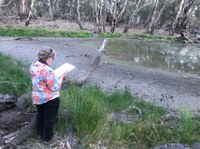2019/20 Frog Survey - Upper section of the Yanco Creek System
Frog Survey in partnership with Charles Sturt University
The summer of 2019/20 saw an extended drought across the Yanco Creek System and much of inland NSW.
To find out how out native wetland fauna was faring, a frog refuge study was undertaken by YACTAC in partnership with Charles Sturt University.
The study aimed to find out how and where frog populations were surviving the drought. The study addressed a few key questions:
- Were frogs persisting in our creek environments during drought?
- Were there native frogs persisting in farm dams and irrigation infrastructure?
- Could we find any threatened southern bell frogs? If so, where were they surviving during drought?
- What factors could we identify that might make a wetland or creek a good refuge habitat for frogs?
The survey looked at several sites along the Yanco, Billabong and Colombo Creeks. Overall, seven species were identified: spotted marsh frog, barking marsh frog and eastern sign-bearing froglet, eastern banjo frog, giant banjo frog, Peron’s tree frog and the southern bell frog.
Spotted marsh frog and Peron’s tree frog were found almost everywhere with eastern sign-bearing froglet and barking marsh frog found at a high proportion of sites.
The threatened southern bell frog were found at two sites last spring, with single frogs found in one farmhouse dam and in the Yanco Creek.
By January 2020 however, we found plenty of southern bell frogs at one site - out calling on top of freshly inundated wetland vegetation mats. This coincided with an accommodating rise in creek water levels thanks to environmental flows and inter-valley transfer flows (thanks CEWO, DPI and WaterNSW).

Thanks to all of the landholders in our community that helped us to find and access sampling sites and to the The Murrumbidgee Field Naturalists who gave their time to assist with surveys.
Dr Dale McNeil





